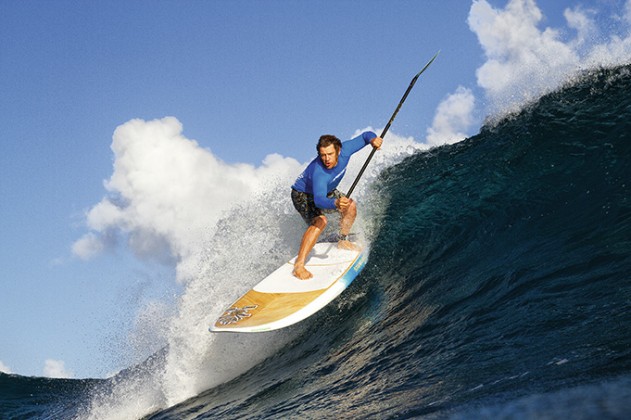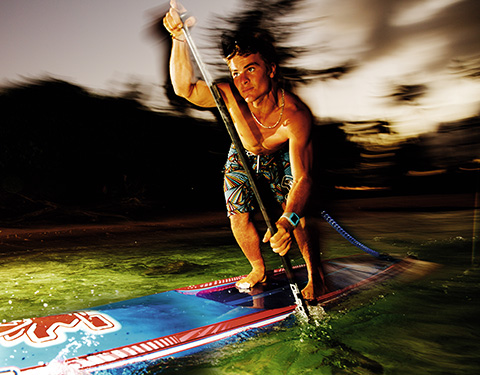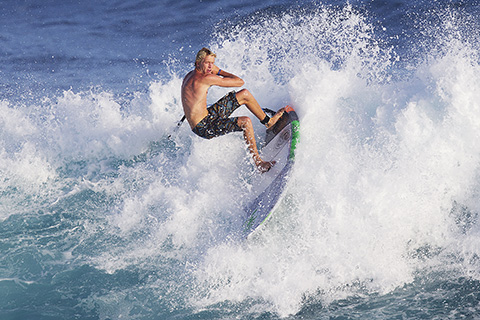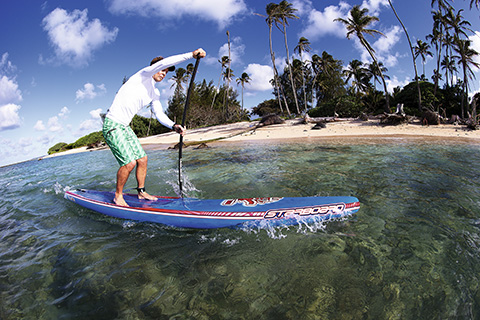KNOWLEDGE : SHAFTS N BLADES – IT’S ALL ABOUT THE PADDLE!
Words: Finn Mullen Photos: John Carter
Cars need engines, bikes need pedals and SUPs need paddles. Finn Mullen delves into the world of paddles and paddling with tips from the top on paddle length, size and technique.
It’s always interesting hearing people’s background before getting into SUP; kitesurfing, surfing and windsurfing seem to be the most popular but very few proportionately come from a paddle sport background. As a result, there is a great deal of crossover board skills but a huge knowledge gap in paddle equipment and technique. I myself am just as guilty, my formative years in SUP were spent with a plastic paddle, deeming carbon paddles a high tech solution to a low tech sport, I resolutely abstained. Until that was, I had a go on my friend’s carbon paddle and realised I had spent my early years paddling with twice the effort for half the reward. Think of paddles as the absolute most important piece of kit you can have as a paddleboarder and spend accordingly. Investing time and money to find the right paddle type and length is the best way to enjoy SUP and perfect your technique without overuse injuries.
Specific to you
My own paddle journey was one of trial and error, I felt aware that my blade size and height were too great and both needed to be reduced. Trust your instincts here, if it doesn’t feel right, experiment, but do it incrementally. My length adjustments I made too radically at first, it’s best to go inch at a time to fine tune and let your body position gradually adjust, especially if you are cutting down your paddle length in line with the trend in sup surfing. The best way to experiment is try other people’s paddles; shops and demo days are useful here. As you’ll read later, SUP megastar, Connor Baxter, used an adjustable to really fine tune his preferred height. We are all built differently and everyone has their own tastes, which is why it’s good to experiment within the differing parameters of length and blade size.
Blade size and length
At 6’1’’ and 85 kgs, in the space of a year, I went from the largest paddle in Starboard’s blade range to the smallest and all those niggling shoulder and back pains disappeared as a result – food for thought for those who paddle in pain! The majority of my SUP time is spent in the surf, here small blades (430cm) I find don’t unsettle small sup boards as you are paddling in and are way easier to throw about in paddle transitions. For boards bigger than 8’5’’ or indeed if it looks like it might be high current, I step up from a 430cm to 475 blade so I have a bit more push, similar to how one might change gears in a bike or car. Paddling in for waves is all about quick strokes, high cadence and a small blade really helps here to reduce your dead time between strokes. Similar to prone surfing, when you paddle in you don’t want big strokes, it’s all about accelerating and keeping the board moving. On the flip side when I ‘m just cruising recreationally and admiring the view I don’t mind moving up a paddle size as my strokes are slower and longer. Length wise, I use eye height for my low volume (8’5 and under) boards where the rail is partially submerged and thus paddle height can be lower as well as shorter paddles being so much more manoeuvrable in the surf. A shorter paddle I also find helps you stay low, ready to spring or compress as well as lowering your centre of gravity for better balance. Stepping up in length and volume for SUP surfing boards of 8’5 and above, where the rail is higher in the water, I increase the paddle length by an inch accordingly to compensate. For recreational paddling I use fist above head height for a little more reach on the longer, slower strokes.
Amongst my peers, I have noticed there is still room for variation in taste in preferences, so to help focus the parameters, I polled a selection of the world’s top paddleboarders for an insight into their paddle quivers and technique tips – read on and learn from some of the best in the business!
Zane Schweitzer – All round competitor and innovator:
When it comes to paddles, I am very particular. After 8 years of standup paddling, I am feeling that it’s important for not only your technique and style, but also for your health, to have the proper sized blade and shaft. I plan on paddling for the rest of my life, and with too big a blade or wrong sized shaft, it’s easy to hurt your back and shoulders, especially after extensive training and paddling over years.
I have more recently been using smaller blades to help with my lower back issues, and also to help adapt with my high cadence paddle style. I’ve been using the Starboard Enduro XS 430 for SUP Surfing and the High Aspect M for most races in sprints and flat water. If I am downwind paddling, I might opt for a tad larger blade and more lengthy shaft because of the higher speeds we are reaching and need for reach when at the crest of swells.
For length I like around 72-73 inches for racing, and 69-71 for sup surfing. (Zane is 5’7’’ / 67” tall). I’ve always preferred a bit more length when SUP Surfing for added reach when performing airs and to aid recovery, but a shorter paddle for sure helps with balance.
Connor Baxter – Champion racer:
I am 6’1” (73”) and for surfing the top of my handle is about eye level at 68”. The
reason it is so short is because I ride a 7’1” Starboard Pro that I sink on so I need a shorter paddle to compensate. For the same reason, my blade size is a Starboard Enduro XS 430 so I can take a bunch of small quick strokes to get going.
For my racing paddles, it is 77” and I have it about a fist and a thumb down above my head, a Shaka without the pinky. How I found this height was by using an adjustable paddle for a week straight and moving it up or down a few inches. For my blade size I am using my Starboard medium 545. This is a smaller blade that allows me to have a higher stroke rate. If you are doing more distance races and you’re a stronger, bigger guy, a bigger blade is better. I have a quick stroke rate so that’s why I use a shorter and smaller blade.
My top tips for paddle technique are to keep your abs flexed at all times with your back straight. Have a comfortable bend in your knees and elbows but for the most part fairly straight. Then you want to find a point on the nose of board that you can reach out too. It has to be a comfortable distance so you are reaching out as far as you can without letting your hands come off the paddle and it doesn’t throw your balance off. The next step is to open your chest and twist to the opposite side you are paddling on and then when you stroke, twist back to normal. Your stroke should end at your feet and never too far past it; otherwise you will be dragging your paddle. Once you do these few steps, repeat until you reach your target and always have fun and never give up!
Izzi Gomez – World champion SUP surfer:
My Height is 5’6’’ (66”) and I use a 66” paddle. I use a shorter paddle for surfing so that I can get a better stroke and so that my paddle doesn’t get stuck in the wave.
For Racing I use 77”, 4 inches above my head – I like to use a longer paddle so I don’t strain my back in longer distances.
My top tip for paddling is to make sure you hinge at the waist when paddling, so you don’t hurt your back.
Bart de Zwart – SUP surfer, adventurer and champion racer:
My Height is 5’11’’ (70”) and I use a Starboard Enduro carbon paddle, 78” in length for racing. I use a blade size 475cm for short races and a medium 525cm for long distance.
For adventure I use the same length, with a medium blade; with long distance races and adventure paddling I make long powerful strokes. That’s why I like a long paddle with a slightly bigger blade size. For short races my paddle frequency is a lot higher, so I use a smaller blade.
In the waves I use a shorter paddle just because it is easy to manoeuvre.
My paddling tip is reach far and turn your body with the paddle movement so you use your whole core.
Fiona Wylde – top US surfer and racer:
(Fiona made it from the trials into the main men’s SUP surfing competition at Sunset Beach, Hawaii!)
I’m 5’2’’ (62”) and for racing I use Werner Paddle’s Grand Prix Small Fit with a small blade. My paddle is 74” long, which is pretty long and optimum for downwinders. For shorter races and upwind races I use a paddle that is 72” long. When I extend my arm above my head, my race paddle reaches to the palm of my hand on the 74’’ and my wrist with the 72’’.
For surfing I use Werner Paddle’s Nitro Small Fit with a small blade. My paddle is 64” long, just about two inches above my head. I keep this paddle short so I can stay close to the wave and stay in the pocket where the most power of the wave is.
For recreational paddling I would suggest a paddle that reaches your wrist when your arm is extended above your head. You don’t want a paddle too long or on the contrary too short, you want it just right… It’s ok to be like Goldilocks when finding a paddle that fits you right.
Here are two things that will get you paddling faster and with good technique. First make sure your paddle blade angle is facing away from you. Second, take the paddle out of the water at your feet. As soon as you pull the paddle past your feet, you will be lifting water when you take your paddle out of the water and that’s a lot of effort and it will slow you down. Have fun and see you out there on the water!
Marie Buchanan – Multiple British SUP Champion:
I’m 5’5 and I generally have two main paddle lengths and two blade size choices for both racing and down-winding and adventure / touring. My longer paddle is 74”, some 8” overhead and the shorter paddle is 72” inches, about 6” above head height. Then I alternate between a medium high aspect blade at 545cm and a small high aspect blade of 505cm.
For long distance paddling and racing in calm conditions (flat water and light winds) I would usually use my longer length paddle and larger 545cm blade. Calm conditions generally mean increased stability and glide, allowing for maximal benefit and efficiency to be gained from using a larger blade and a longer shaft. The longer length allows for a maximal reach and the larger blade means increased power per stroke. This hopefully translates into increased glide and distance travelled per stroke, which essentially means more speed!
For shorter races, like technical racing around a series of buoys or in and out through surf or for distance racing or downwind paddling in windy choppy conditions, I will generally opt for my slightly shorter paddle and smaller 505cm blade. A shorter paddle promotes and compliments a lower centre of gravity and a smaller blade allows for a higher cadence making up for the reduced amount of glide associated with choppy / windy conditions.
NB: A higher stroke rate/cadence is more characteristic of racing on the shorter race board classes e.g. 12’6 where the reduced waterline length results in less glide per stroke and reduced speed compared to the same person racing on a longer 14’ board. On a 12’6 board I would tend to adopt a more rapid stroke rate to make up for this reduced glide per stroke, a smaller, shorter paddle allows for this and aids acceleration between buoy turns and following beach transitions.
There are other variables such as board volumes and shapes which affect where you are standing in relation to the waterline, which might also affect my choice of paddle length choice! On the Starboard Ace, which has the sunken deck, you are pretty much standing at waterline level and therefore I would use a shorter paddle to compensate for this. The opposite is true for an inflatable board or a touring board where I might be stood several inches above the water level and would need a longer paddle regardless of board length.
My top tip for paddle technique is to try to be relaxed and flowing in your paddle stroke, it shouldn’t be too effortful. Be centred on the board and light on your feet. Keep the board trimmed (nose to tail and rail to rail). Avoid causing a splash as the paddle enters and exits the water and most importantly make sure the blade exits the water before it passes your feet/hip. If you exit the blade too late, it will act like a brake, slowing you down significantly and may even pull you off balance!




